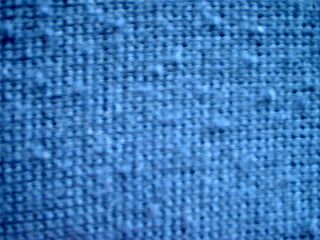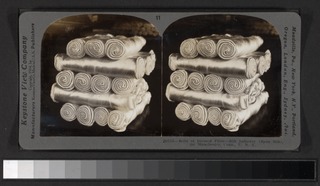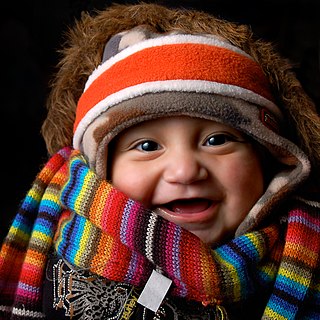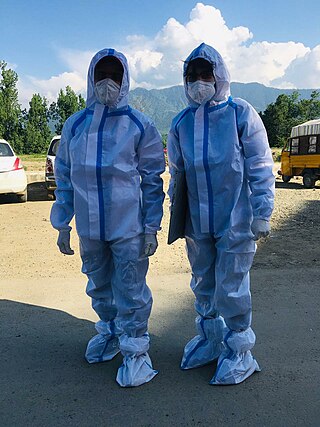Related Research Articles

Textile is an umbrella term that includes various fiber-based materials, including fibers, yarns, filaments, threads, different fabric types, etc. At first, the word "textiles" only referred to woven fabrics. However, weaving is not the only manufacturing method, and many other methods were later developed to form textile structures based on their intended use. Knitting and non-woven are other popular types of fabric manufacturing. In the contemporary world, textiles satisfy the material needs for versatile applications, from simple daily clothing to bulletproof jackets, spacesuits, and doctor's gowns.

Dyeing is the application of dyes or pigments on textile materials such as fibers, yarns, and fabrics with the goal of achieving color with desired color fastness. Dyeing is normally done in a special solution containing dyes and particular chemical material. Dye molecules are fixed to the fiber by absorption, diffusion, or bonding with temperature and time being key controlling factors. The bond between dye molecule and fiber may be strong or weak, depending on the dye used. Dyeing and printing are different applications; in printing, color is applied to a localized area with desired patterns. In dyeing, it is applied to the entire textile.

A technical textile is a textile product manufactured for non-aesthetic purposes, where function is the primary criterion. Technical textiles include textiles for automotive applications, medical textiles, geotextiles, agrotextiles, and protective clothing.
A staple fiber is a textile fiber of discrete length. The opposite is a filament fiber, which comes in continuous lengths. Staple length is a characteristic fiber length of a sample of staple fibers. It is an essential criterion in yarn spinning, and aids in cohesion and twisting. Compared to synthetic fibers, natural fibers tend to have different and shorter lengths. The quality of natural fibers like cotton is categorized on staple length such as short, medium, long-staple, and extra long. Gossypium barbadense, one of several cotton species, produces extra-long staple fibers. The staple fibers may be obtained from natural and synthetic sources. In the case of synthetics and blends, the filament yarns are cut to a predetermined length.

The textile bleaching is one of the steps in the textile manufacturing process. The objective of bleaching is to remove the natural color for the following steps such as dyeing or printing or to achieve full white. All raw textile materials, when they are in natural form, are known as 'greige' material. They have their natural color, odor and impurities that are not suited to clothing materials. Not only the natural impurities will remain in the greige material, but also the add-ons that were made during its cultivation, growth and manufacture in the form of pesticides, fungicides, worm killers, sizes, lubricants, etc. The removal of these natural coloring matters and add-ons during the previous state of manufacturing is called scouring and bleaching.

In textile manufacturing, finishing refers to the processes that convert the woven or knitted cloth into a usable material and more specifically to any process performed after dyeing the yarn or fabric to improve the look, performance, or "hand" (feel) of the finish textile or clothing. The precise meaning depends on context.

A pill, colloquially known as a bobble, fuzzball, or lint ball, is a small ball of fibers that forms on a piece of cloth. Pill is also a verb for the formation of such balls.

A bolt is a piece of cloth woven on a loom or created by a knitting machine, as it is processed, stored and/or marketed. Consequently, its dimensions are highly variable – flexible and dependent upon the manufacturing, machinery, quantity, size, thickness and quality of the product. It is a unit used in manufacturing, transport and inventory. It is also used as a descriptor for wallpaper, which uses different fabrication machinery. Being encompassing, it is by its nature a generic and ambiguous term of convenience and context, used to describe fabric and wallpaper.

Greige goods are loom state woven fabrics, or unprocessed knitted fabrics. Greige goods undergo many subsequent processes, for instance, dyeing, printing, bleaching, and finishing, prior to further converting to finished goods such as clothing, or other textile products."Grey fabrics" is another term to refer to unfinished woven or knitted fabrics.

Hand feel is the property of fabrics related to the touch that expresses sensory comfort. It refers to the way fabrics feel against the skin or in the hand and conveys information about the cloth's softness and smoothness. Hand feel is an estimated and subjective property of different fabrics, but nowadays, hand feel could be measured and assessed statistically.
Paper yarn is the yarn made from paper strips chiefly with wood pulp cut into strips and then twisted to form a yarn. Germany invented Paper yarn in the late 19th century, although paper has been used in textiles in Japan for centuries. They used various products made of paper yarn during and after wartime.

Textile performance, also known as fitness for purpose, is a textile's capacity to withstand various conditions, environments, and hazards, qualifying it for particular uses. The performance of textile products influences their appearance, comfort, durability, and protection. Different textile applications require a different set of performance parameters. As a result, the specifications determine the level of performance of a textile product. Textile testing certifies the product's conformity to buying specification. It describes product manufactured for non-aesthetic purposes, where fitness for purpose is the primary criterion. Engineering of high performance fabrics presents a unique set of challenges.
Indutech is the branch of technical textile that deals with textiles used in the diverse industrial applications such as in filtration, conveying, cleaning and other industrial uses.

3D textiles are three-dimensional structures made with different manufacturing methods such as weaving, knitting, braiding, or nonwoven, or made with alternative technologies. 3D textiles are produced with three planar geometry, opposed to 2D textiles that are made on two planes. The weave in 2D textiles is perpendicular. The yarn is fed along two axis: length (x-axis) and width (y-axis), while 3D textiles also have a perpendicular weave, but they have an extra yarn with an angular feeding (z-axis) which creates thickness. 3D weaves are orthogonal weave structures, multilayer structures, and angle interlocks. 3D textiles have more manufacturing opportunities, various properties, and a broader scope of applications. These textiles have a wide range of applications, but they are most commonly used where performance is the primary criterion, such as technical textiles. Composite materials, manufacturing is one of the significant areas of using 3D textiles.
Barré is an unintentional repetitive horizontal pattern in fabrics that is generally undesirable and considered as a defect. It appears as a lateral stripe pattern. Barré occurs for many reasons associated with the manufacturing of textile ensembles like fiber, yarn, fabric manufacturing, weaving or knitting, or finishing faults.

Chemical finishing of textiles refers to the process of applying and treating textiles with a variety of chemicals in order to achieve desired functional and aesthetic properties. Chemical finishing of textiles is a part of the textile finishing process where the emphasis is on chemical substances instead of mechanical finishing. Chemical finishing in textiles also known as wet finishing. Chemical finishing adds properties to the treated textiles. Softening of textiles, durable water repellancy and wrinkle free fabric finishes are examples of chemical finishing.

Scouring is a preparatory treatment of certain textile materials. Scouring removes soluble and insoluble impurities found in textiles as natural, added and adventitious impurities, for example, oils, waxes, fats, vegetable matter, as well as dirt. Removing these contaminants through scouring prepares the textiles for subsequent processes such as bleaching and dyeing. Though a general term, "scouring" is most often used for wool. In cotton, it is synonymously called "boiling out," and in silk, and "boiling off."
A blend is a mixture of two or more fibers. In yarn spinning, different compositions, lengths, diameters, or colors may be combined to create a blend. Blended textiles are fabrics or yarns produced with a combination of two or more types of different fibers, or yarns to obtain desired traits and aesthetics. Blending is possible at various stages of textile manufacturing. The term, blend, refers to spun fibers or a fabric composed of such fibers. There are several synonymous terms: a combination yarn is made up of two strands of different fibers twisted together to form a ply; a mixture or mixed cloth refers to blended cloths in which different types of yarns are used in warp and weft sides.
In textile spinning, yarn realisation (YR), or yarn recovery, is an operational parameter of yarn manufacturing. It is the percentage conversion of raw material to finished yarn. The rest of the waste fibers with less value are compared to the weight of the produced yarn from a given weight of raw material. The quantity of waste removed during the various phases of yarn spinning, such as blow-room, carding, and combing, is often used to determine yarn realisation. Yarn realisation ranges between 85% and 90% in carded cotton yarns and between 67% and 75% in combed cotton yarns.

Medical textiles are various fiber-based materials intended for medical purposes. Medical textile is a sector of technical textiles that focuses on fiber-based products used in health care applications such as prevention, care, and hygiene. The spectrum of applications of medical textiles ranges from simple cotton bandages to advanced tissue engineering. Common examples of products made from medical textiles include dressings, implants, surgical sutures, certain medical devices, healthcare textiles, diapers, menstrual pads, wipes, and barrier fabrics.
References
- ↑ Annapoorani, Grace S. (2018). Agro Textiles and Its Applications. Woodhead Publishing. p. 3. ISBN 978-93-85059-89-6.
- 1 2 Indian Textile Annual & Directory. Eastland Publications. 2001. pp. 111, 112.
- 1 2 Annapoorani, Grace S. (2018). Agro Textiles and Its Applications. Woodhead Publishing. p. 5. ISBN 978-93-85059-89-6.
- 1 2 Ahmad, Sheraz; Rasheed, Abher; Nawab, Yasir (2020). Fibers for Technical Textiles. Springer Nature. pp. 53, 210. ISBN 978-3-030-49224-3.
- 1 2 Patnaik, Asis; Patnaik, Sweta (2019-08-08). Fibres to Smart Textiles: Advances in Manufacturing, Technologies, and Applications. CRC Press. p. 318. ISBN 978-0-429-82193-6.
- 1 2 3 Nawab, Yasir (2016-07-11). Textile Engineering: An introduction. Walter de Gruyter GmbH & Co KG. pp. 6–25. ISBN 978-3-11-042389-1.
- ↑ Textile Trends. Eastland Publications. 2003. p. 45.
- ↑ "TECHNICAL TEXTILES | Home". www.technotex.gov.in. Retrieved 2021-01-07.
- ↑ Textiles, Expert Committee on Technical (2004). Report of the Expert Committee on Technical Textiles. Government of India, Ministry of Textiles. p. 76.
- ↑ JTN Monthly. Osaka Senken Limited. 2000. pp. 84, 32.
- ↑ Ahmad, Sheraz; Rasheed, Abher; Nawab, Yasir (2020). Fibers for Technical Textiles. Springer Nature. p. 54. ISBN 978-3-030-49224-3.
- ↑ Patnaik, Asis; Patnaik, Sweta (2019-08-08). Fibres to Smart Textiles: Advances in Manufacturing, Technologies, and Applications. CRC Press. p. 319. ISBN 978-0-429-82193-6.
- ↑ Singh, Mukesh Kumar (2019-02-13). Engineered Fabrics. BoD – Books on Demand. p. 6. ISBN 978-1-78985-007-9.


